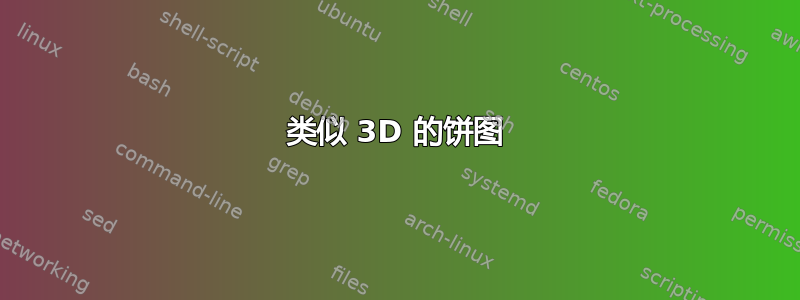
我怎样才能获得这种饼图样式:
平均能量损失
\documentclass[tikz,border=10pt]{standalone}
\usepackage{verbatim}
\begin{comment}
\end{comment}
\begin{document}
\def\angle{0}
\def\radius{3}
\def\cyclelist{{"orange","blue","red","green"}}
\newcount\cyclecount \cyclecount=-1
\newcount\ind \ind=-1
\begin{tikzpicture}[nodes = {font=\sffamily}]
\foreach \percent/\name in {
46.6/Chrome,
24.6/Internet Explorer,
20.4/Firefox,
5.1/Safari,
1.3/Opera,
2.0/Other
} {
\ifx\percent\empty\else % If \percent is empty, do nothing
\global\advance\cyclecount by 1 % Advance cyclecount
\global\advance\ind by 1 % Advance list index
\ifnum3<\cyclecount % If cyclecount is larger than list
\global\cyclecount=0 % reset cyclecount and
\global\ind=0 % reset list index
\fi
\pgfmathparse{\cyclelist[\the\ind]} % Get color from cycle list
\edef\color{\pgfmathresult} % and store as \color
% Draw angle and set labels
\draw[fill={\color!50},draw={\color}] (0,0) -- (\angle:\radius)
arc (\angle:\angle+\percent*3.6:\radius) -- cycle;
\node at (\angle+0.5*\percent*3.6:0.7*\radius) {\percent\,\%};
\node[pin=\angle+0.5*\percent*3.6:\name]
at (\angle+0.5*\percent*3.6:\radius) {};
\pgfmathparse{\angle+\percent*3.6} % Advance angle
\xdef\angle{\pgfmathresult} % and store in \angle
\fi
};
\end{tikzpicture}
\end{document}
答案1
这个答案很大程度上受到启发并依赖于这个答案。它有几个附加功能。绘制饼图变得非常简单,只需说
\path[3d pie chart/.cd,radius=4cm,h=1.5cm,colors={"yellow","strangegreen"}] pic{3d pie chart={36/Nuts,64/Honey}};
以下是代码和结果:
\documentclass[tikz,border=3mm]{standalone}
\usetikzlibrary{fadings}
\definecolor{strangegreen}{RGB}{15,111,83}
\tikzset{pics/wedge/.style={code={%
\tikzset{wedge/.cd,#1}
\def\kvw##1{\pgfkeysvalueof{/tikz/wedge/##1}}
\pgfmathtruncatemacro{\itest}{3*(1+sign(sin(\kvw{alpha})))+1+sign(sin(\kvw{beta}))}
\ifcase\itest
%0: alpha>180,beta>180
\draw[fill=\kvw{color},very thin]
(\kvw{alpha}:\kvw{radius})
-- ++(0,-\kvw{h}) arc(\kvw{alpha}:\kvw{beta}:\kvw{radius})
-- ++(0,\kvw{h}) arc(\kvw{beta}:\kvw{alpha}:\kvw{radius});
\or
%1: alpha>180,beta=0,180
\draw[fill=\kvw{color},very thin]
(\kvw{alpha}:\kvw{radius})
-- ++(0,-\kvw{h}) arc(\kvw{alpha}:\kvw{beta}:\kvw{radius})
-- ++(0,\kvw{h}) arc(\kvw{beta}:\kvw{alpha}:\kvw{radius});
\or
%2: alpha>180,beta<180
\draw[fill=\kvw{color},very thin]
(\kvw{alpha}:\kvw{radius})
-- ++(0,-\kvw{h}) arc(\kvw{alpha}:360:\kvw{radius})
-- ++(0,\kvw{h}) arc(360:\kvw{alpha}:\kvw{radius});
\or
%3: alpha=0,180,beta>180
\draw[fill=\kvw{color},very thin]
(180:\kvw{radius})
-- ++(0,-\kvw{h}) arc(180:\kvw{beta}:\kvw{radius})
-- ++(0,\kvw{h}) arc(\kvw{beta}:180:\kvw{radius});
\or
%4: alpha=0,180,beta=0,180
\draw[fill=\kvw{color},very thin]
(180:\kvw{radius})
-- ++(0,-\kvw{h}) arc(180:0:\kvw{radius})
-- ++(0,\kvw{h}) arc(0:180:\kvw{radius});
\or
%5: alpha=0,180,beta=<180
\or
%6: alpha<180,beta=>180
\draw[fill=\kvw{color},very thin]
(180:\kvw{radius})
-- ++(0,-\kvw{h}) arc(180:\kvw{beta}:\kvw{radius})
-- ++(0,\kvw{h}) arc(\kvw{beta}:180:\kvw{radius});
\or
%7: alpha<180,beta=0,180
\pgfmathtruncatemacro{\ibeta}{sign(cos(\kvw{beta}))}
\ifnum\ibeta=1
\draw[fill=\kvw{color},very thin]
(180:\kvw{radius})
-- ++(0,-\kvw{h}) arc(180:360:\kvw{radius})
-- ++(0,\kvw{h}) arc(360:180:\kvw{radius});
\fi
\or
%8: alpha<180,beta<180
\pgfmathtruncatemacro{\ibeta}{sign(sin(\kvw{alpha})-sin(\kvw{beta}))}
\ifnum\ibeta=1
\draw[fill=\kvw{color},very thin]
(180:\kvw{radius})
-- ++(0,-\kvw{h}) arc(180:360:\kvw{radius})
-- ++(0,\kvw{h}) arc(360:180:\kvw{radius});
\fi
\fi
\path[fill=\kvw{color},draw=black] (0,0)--
(\kvw{alpha}:\kvw{radius}) arc(\kvw{alpha}:\kvw{beta}:\kvw{radius})
--cycle;
}},
wedge/.cd,alpha/.initial=0,beta/.initial=0,%beta > alpha!
color/.initial=blue,
mix color/.initial=gray,radius/.initial=3cm,h/.initial=1cm,
/tikz/.cd,
pics/3d pie chart/.style={code={
\def\kvw##1{\pgfkeysvalueof{/tikz/3d pie chart/##1}}
\begin{scope}[yscale=\kvw{aspect},transform shape]
\path[preaction={fill=black,opacity=.8,
path fading=circle with fuzzy edge 20 percent}]
(0,-\kvw{h}-\kvw{radius}/4.5)
circle[radius=1.05*\kvw{radius}];
\pgfmathsetmacro{\mysum}{0}
\foreach \XX/\ZZ in {#1}
{\pgfmathsetmacro{\mysum}{\mysum+\XX}
\xdef\mysum{\mysum}}
\pgfmathsetmacro{\myangle}{\kvw{alpha0}}
\foreach \XX/\ZZ [count=\YY starting from 0,remember=\myangle as \myangle] in {#1}
{\pgfmathsetmacro{\myangleB}{\myangle+\XX*(360/\mysum)}
\pgfmathsetmacro{\mycolor}{{\kvw{colors}}[\YY]}
\pic{wedge={alpha=\myangle,beta=\myangleB,color=\mycolor,
radius/.expanded=\kvw{radius},
h/.expanded=\kvw{h}
}};
\fill (\myangle/2+\myangleB/2:\kvw{radius}*\kvw{eccentricity})
coordinate (\kvw{cname}-\YY) circle[radius=2pt];
\pgfmathtruncatemacro{\mysign}{sign(cos(\myangle/2+\myangleB/2))}
\draw[thick] (\kvw{cname}-\YY) --
++(\myangle/2+\myangleB/2:\kvw{armA}) -- ++
(\mysign*3,0)
\ifnum\mysign<0
node[above right,transform shape=false]{\ZZ}
node[below right,transform shape=false]{\XX\%}
\else
node[above left,transform shape=false]{\ZZ}
node[below left,transform shape=false]{\XX\%}
\fi;
\pgfmathsetmacro{\myangle}{\myangleB}
}
\shade[left color=black,middle color=white,right color=gray,opacity=0.4]
(180:\kvw{radius})
-- ++(0,-\kvw{h}) arc(180:360:\kvw{radius})
-- ++(0,\kvw{h}) arc(360:180:\kvw{radius});
\end{scope}
}},
3d pie chart/.cd,
colors/.initial={"blue","red","orange","green","yellow"},
radius/.initial=3cm,h/.initial=1cm,alpha0/.initial=0,
aspect/.initial=0.6,eccentricity/.initial=0.7,cname/.initial=c,
armA/.initial=2cm,armB/.initial=3cm
}
\begin{document}
\begin{tikzpicture}[font=\sffamily]
\path[3d pie chart/.cd,radius=4cm,h=1.5cm,colors={"yellow","strangegreen"}] pic{3d pie chart={36/Nuts,64/Honey}};
\path[xshift=12cm,3d pie chart/.cd,radius=4cm,h=1.5cm,alpha0=45,
colors={"green","yellow","strangegreen"}]
pic{3d pie chart={13/Nuts,5/Honey,82/Beer}};
\end{tikzpicture}
\end{document}
\documentclass{scrartcl}
\usepackage{tikz}
\usetikzlibrary{fadings}
\definecolor{strangegreen}{RGB}{15,111,83}
\pgfkeys{%
/piechartthreed/.cd,
scale/.code = {\def\piechartthreedscale{#1}},
mix color/.code = {\def\piechartthreedmixcolor{#1}},
background color/.code = {\def\piechartthreedbackcolor{#1}},
name/.code = {\def\piechartthreedname{#1}}}
\newcommand\piechartthreed[2][]{%
\pgfkeys{/piechartthreed/.cd,
scale = 1,
mix color = gray,
background color = white,
name = pc}
\pgfqkeys{/piechartthreed}{#1}
\begin{scope}[scale=\piechartthreedscale]
\begin{scope}[xscale=5,yscale=3]
\path[preaction={fill=black,opacity=.8,
path fading=circle with fuzzy edge 20 percent,
transform canvas={yshift=-15mm*\piechartthreedscale}}] (0,0) circle (1cm);
\pgfmathsetmacro\totan{0}
\global\let\totan\totan
\pgfmathsetmacro\bottoman{180} \global\let\bottoman\bottoman
\pgfmathsetmacro\toptoman{0} \global\let\toptoman\toptoman
\begin{scope}[draw=black,thin]
\foreach \an/\col [count=\xi] in {#2}{%
\def\space{ }
\coordinate (\piechartthreedname\space\xi) at (\totan+\an/2:0.75cm);
\ifdim 180pt>\totan pt
\ifdim 0pt=\toptoman pt
\pgfmathsetmacro\toptoman{180}
\global\let\toptoman\toptoman
\else
\fi
\fi
\fill[\col!80!gray,draw=black] (0,0)--(\totan:1cm) arc(\totan:\totan+\an:1cm)
--cycle;
\pgfmathsetmacro\finan{\totan+\an}
\ifdim 180pt<\finan pt
\ifdim 180pt=\bottoman pt
\shadedraw[left color=\col!20!\piechartthreedmixcolor,
right color=\col!5!\piechartthreedmixcolor,
draw=black,very thin] (180:1cm) -- ++(0,-3mm) arc (180:\totan+\an:1cm)
-- ++(0,3mm) arc (\totan+\an:180:1cm);
\pgfmathsetmacro\bottoman{0}
\global\let\bottoman\bottoman
\else
\shadedraw[left color=\col!20!\piechartthreedmixcolor,
right color=\col!5!\piechartthreedmixcolor,
draw=black,very thin](\totan:1cm)-- ++(0,-3mm) arc(\totan:\totan+\an:1cm)
-- ++(0,3mm) arc(\totan+\an:\totan:1cm);
\fi
\fi
\pgfmathsetmacro\totan{\totan+\an} \global\let\totan\totan
}
\end{scope}
\end{scope}
\end{scope}
}
\begin{document}
\begin{tikzpicture}
\piechartthreed[scale=0.8,
% background color=orange!50,
mix color= darkgray]
{135/yellow,225/strangegreen}
\foreach \i in {1,...,2} { \fill (pc \i) circle (.5mm);}
\draw[darkgray] (pc 1) -- ++(4,0) coordinate (s1) node[anchor=south east] {Sector 1}
node[anchor=north east]
{37.5\%};
\draw[darkgray] (pc 2) -- ++(-1,-1) coordinate (s2) --
++(-4,0) node[anchor=south west] {Sector 2}
node[anchor=north west]
{62.5\%};
\end{tikzpicture}
\end{document}





